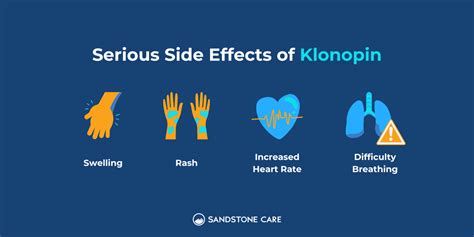Klonopin, also known by its generic name clonazepam, is a medication primarily used to treat seizure disorders and panic attacks. It belongs to a class of drugs called benzodiazepines, which work by enhancing the effect of the neurotransmitter gamma-aminobutyric acid (GABA) in the brain to produce a calming effect. While Klonopin can be effective in managing symptoms of anxiety and seizure disorders, it is not without side effects. Understanding these side effects is crucial for patients and healthcare providers to make informed decisions about its use.
Common Side Effects
Many people who take Klonopin experience side effects, although the severity and type can vary widely among individuals. Some of the most common side effects include:
- Drowsiness: One of the most prevalent side effects of Klonopin is drowsiness or sedation. This is due to its depressant effects on the central nervous system.
- Dizziness: Patients might feel lightheaded or dizzy, which can increase the risk of falls, especially in older adults.
- Fatigue: Feeling tired or lacking energy is another common complaint among users of Klonopin.
- Muscle Weakness: Klonopin can cause a decrease in muscle tone, leading to feelings of weakness.
- Depression: While Klonopin is used to treat anxiety, which can be a symptom of depression, it can sometimes contribute to or worsen depressive symptoms in some individuals.
- Memory Problems: Benzodiazepines, including Klonopin, can impair short-term memory. Users might find it difficult to learn new information or recall recent events.
- Weight Changes: Some people may experience weight gain or, less commonly, weight loss while taking Klonopin.
Less Common but Serious Side Effects
While less frequent, some side effects of Klonopin can be more serious and require immediate medical attention. These include:
- Respiratory Depression: Especially when combined with other central nervous system depressants, Klonopin can slow down breathing rates, which can be life-threatening.
- Increased Seizure Activity: Paradoxically, in some cases, Klonopin can increase the frequency or severity of seizures, particularly if the dosage is not adequate or if the medication is suddenly stopped.
- Psychotic Episodes: Rarely, Klonopin can cause psychotic episodes, characterized by a disconnection from reality, in individuals with a history of psychiatric disorders.
- Allergic Reactions: Although rare, some individuals may experience an allergic reaction to Klonopin, which can manifest as hives, itching, swelling, severe dizziness, or difficulty breathing.
Long-Term Use and Dependence
One of the significant concerns with benzodiazepines like Klonopin is the potential for dependence and addiction. Long-term use can lead to physical dependence, and stopping the medication abruptly can cause withdrawal symptoms. These symptoms can range from mild (anxiety, insomnia) to severe (seizures, psychosis). It is crucial for patients to work closely with their healthcare provider to taper off the medication safely if long-term use is anticipated or has already occurred.
Special Considerations
- Pregnancy and Breastfeeding: Klonopin can pass through the placenta and into breast milk, potentially causing harm to the fetus or baby. Women who are pregnant, planning to become pregnant, or breastfeeding should discuss the risks and benefits with their healthcare provider.
- Elderly Patients: Older adults may be more susceptible to the sedative effects of Klonopin and are at a higher risk of falls and other accidents. Dosages may need to be adjusted, and monitoring for side effects is crucial.
- Interactions with Other Medications: Klonopin can interact with various medications, including other benzodiazepines, opioids, antidepressants, and antihistamines, increasing the risk of adverse effects. Patients should inform their healthcare provider about all medications and supplements they are taking.
Conclusion
Klonopin can be an effective treatment for seizure disorders and panic attacks, but its use must be carefully considered due to its potential side effects and risks, particularly with long-term use or in certain populations. Patients should be closely monitored by their healthcare provider, and open communication about any experienced side effects is essential to manage them effectively and minimize risks. As with any medication, the benefits of Klonopin must be weighed against its potential drawbacks, and alternative treatments should be considered when appropriate.
Frequently Asked Questions
What is the primary use of Klonopin?
+Klonopin, or clonazepam, is primarily used to treat seizure disorders and panic attacks by enhancing the effect of the neurotransmitter GABA in the brain.
Can Klonopin cause dependence?
+Yes, one of the significant concerns with Klonopin and other benzodiazepines is the potential for physical dependence and addiction, especially with long-term use.
How should Klonopin be discontinued to avoid withdrawal symptoms?
+To avoid withdrawal symptoms, Klonopin should be tapered off gradually under the guidance of a healthcare provider. The rate of tapering may vary depending on the individual’s circumstances, including the dosage and duration of use.
Can Klonopin be used during pregnancy or breastfeeding?
+Klonopin can pass through the placenta and into breast milk, potentially causing harm. Its use during pregnancy or breastfeeding should be carefully considered and discussed with a healthcare provider to weigh the benefits against the risks.



